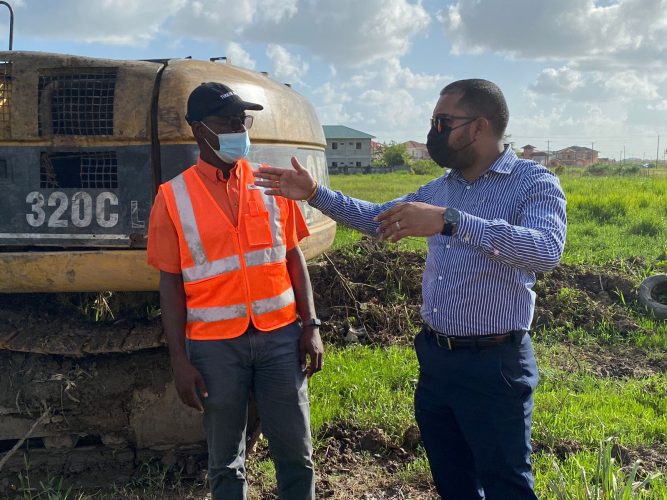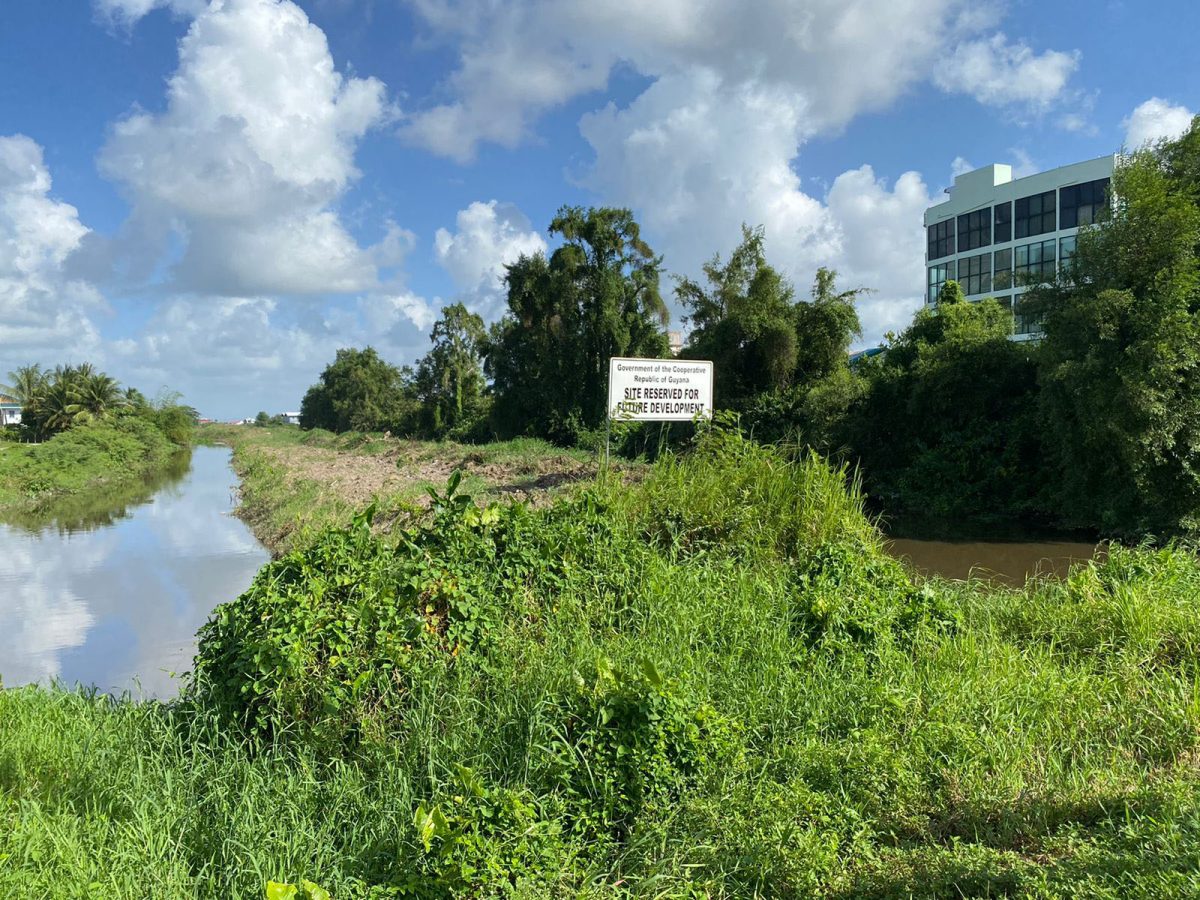By Lakhram Bhagirat
Although key environmental matters and the hiring of a contractor are still to be concluded, the government is pressing ahead with plans for a new bridge over the Demerara River and has invited Region Four to give its no-objection to the project.
The government has already commenced preparatory works for the new four-lane, high-span fixed bridge across the Demerara River and according to the Ministry of Public Works’ Chief Transport Planning Officer, only a “handful” of properties would have to be acquired.
The new bridge is expected to land in the vicinity of Nandy Park on the eastern side of the Demerara River and at La Grange/Meer-Zorgen on the West Bank.

Yesterday, Region Four Chairman Daniel Seeram and members of the Regional Works Committee toured the proposed site for the bridge at Nandy Park. They were given the technical details by Chief Transport Planning Officer, Patrick Thompson.
Based on the information provided, the bridge is expected to land some 700 metres inland from the eastern bank of Demerara and will be elevated 50 meters at the beginning of the river channel – which is closer to the east bank.
“Marine vessels navigate through the channel (and) to the point where the channel meets a bridge, the bridge will be elevated about 50 meters above the water level and so all the vessels that traverse the Demerara River, 50 meters would be would be more than adequate for them to get across without any issues,” he said while outlining that the conclusion was drawn following research.
Earlier this month, Government announced that it will be engaging China State Construction Engineering Corporation (CSCEC) on the construction of the bridge since it submitted the lowest responsive bid. The company still has to accept the award and enter into negotiations with the government as it relates to the contract and design of the bridge.
The negotiations are expected to commence after President Irfaan Ali’s return to Guyana from Glasgow, Scotland where he is attending the United Nations Climate Change Summit (COP26).
CSCEC, in its tender document, pegged the cost for the construction of the bridge at US$256,638,289 and it is based on the Design, Build and Finance (DBF) option, or Design, Build, Finance, Operate and Maintain (DBFOM).
The Scope of Works in the design/build contract included the complete design and construction of a two-lane dual (four-lane) carriageway, hybrid cable-stayed centre-span bridge with concrete box/T-beam girder approach bridge structures, and must include bridge collision protection, a navigation span to accommodate Handy-max vessel navigation aids, lighting, signage, and all other ancillary works, an access road with a minimum of 50 metres up to abutments, toll-collection buildings and ancillary buildings on the West Bank of the Demerara River.
On the western end, it is anticipated that no lands would have to be acquired but on the eastern side, Thompson said a “few” plots would have to be acquired.
“Best to my knowledge, there aren’t any properties on the west bank that is within the alignment of the bridge. There are a few properties on the east bank here that will fall within the alignment to the bridge and we are in the process of, as I said earlier, trying to commence what is required by law to acquire those properties,” he told reporters during the site visit.
When pressed, by the media, as to a number of properties to be acquired, Thompson said that would be determined as time progresses but reiterated that it will just be a “handful”.
Thompson, when asked about the level of consultations done with the stakeholders, said that there have been consultations at various levels of the project and that the process is continuous. However, he could not indicate when they engaged the residents rather he pointed to the process where the Environmental Protection Agency (EPA) notifies of the project. He further informed that it was there that stakeholders could have made objections but they have received none so far.
Nevertheless, he did indicate that there will be more opportunities for engagement with the stakeholders.
“It will be important that they (stakeholders) are aware of the project and understand the impact that it will have and that’s why there has been an application with the EPA and the application has a project summary. The project summary has details about potential impacts that the bridge in this area may have and residents have the opportunity to if they have any concerns about those impacts to raise it to the EPA for it to be dealt with,” Thompson informed.
The EPA has been coming in for harsh criticisms following its decision not to require an Environmental Impact Assessment (EIA) for the project. That decision has been appealed but the Environmental Assessment Board has yet to give a date for the hearing.
Thompson told reporters they have engaged the utility companies as part of the preparation for the commencement of the project and there would be minimal relocation of those utilities’ infrastructure. He added that they would also have to reshape drainage in the area.
Explaining the intended benefits of the bridge, the Planning Officer said that the fixed bridge means no retraction or downtime to vehicular traffic. He added that the four lanes would provide for the doubling of vehicular traffic explaining that the current double lane bridge has the capacity of about 1500 vehicles per hour.
No-objection
Seeram said that he received a letter from the Ministry of Public Works seeking a no-objection from the Regional Democratic Council (RDC) of Region Four (Demerara-Mahaica). The letter arrived on November 02 and that prompted the visit to the site.
He said that the project is welcomed by the Region since it adds to its development and not only links Regions Three and Four but also Two, Seven and Eight as well.
“We would have raised concerns this afternoon, not on the technical aspect much, but we are looking at the social impact it will have with the residents of the area. We were guided that some amount of consultation was already done via the Ministry of Public Works and the Environmental Protection Agency and I’m guessing the client who will be the actual contractor chosen for this bridge,” he said.
“This project is still somewhat in its infancy although some amount of work was done on it. However, such a construction in this era will be massive and will be impacting a lot of communities within the areas. We would have noted that some of the properties would fall directly in the … zone of the Demerara Bridge and that has caused some amount of legal decisions to be made in terms of public acquisition of lands to facilitate that construction,” Seeram added.
He did indicate that the Region would be hosting its own consultation with stakeholders there before giving its no-objection to the project. The Regional Chairman said that he intends to work with the Central Ministry to address the concerns of the residents.
“Right here right now, I’d love to give the no-objection because the project is warranted for the Region but we have processes that we have to follow right. My governance strategy at the Region is meaningful consultation, thorough discussions, leading to inform decisions. So I’m leaning towards yes, giving that no-objection, however, I have to make sure that consultations were happening below me in terms at the local authorities level and I must check with the other stakeholders before I can give that final no objection on behalf of the Region,” the Regional Chair said.
Once completed, the bridge is expected to have a lifespan of 50 years.





